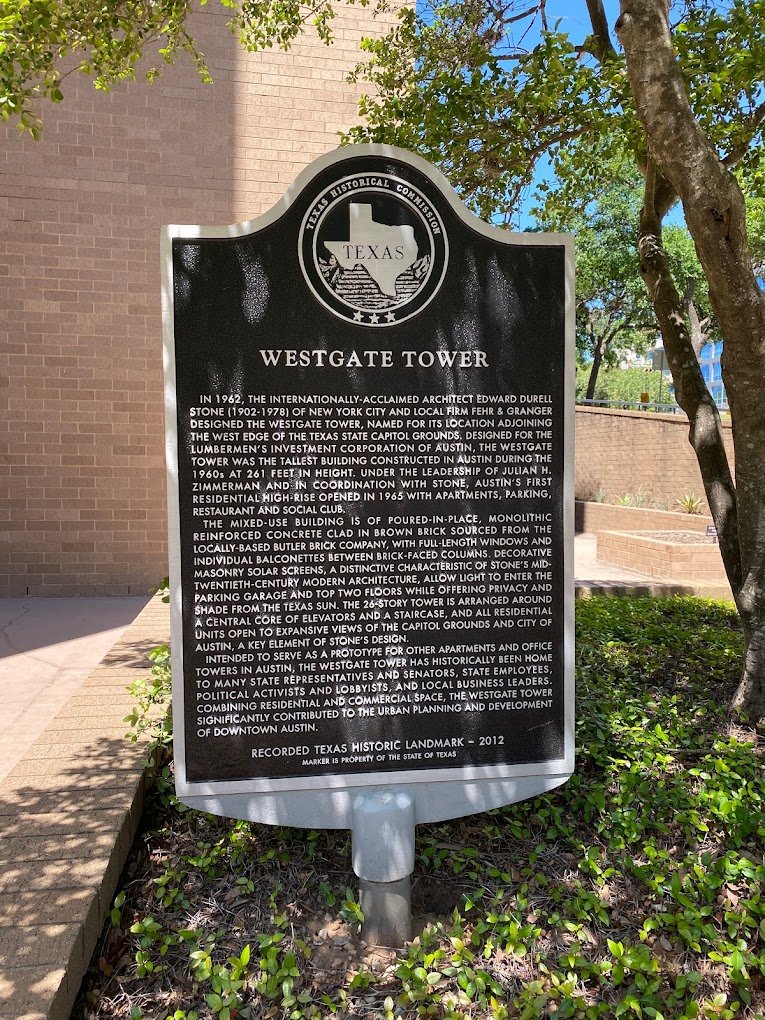Our History
In 1852, noted Austin architect Abner Cook (1814-1884) built a home [where Westgate Tower is now located] for Dr. Samuel Garner Haynie (1806-1877), who was elected Mayor of Austin four times (1850, 1851, 1863, and 1864). Cook, who was also working on the 1852-1854 Texas State Capitol around the same time, built the house with a federal design, containing Greek revival elements. The front façade featured a two-story portico with a pair of fluted ionic columns flanked by outer Doric piers.
Because of financial difficulties, Haynie was forced to sell the house to Cook shortly after its completion. The Cook family moved into the home by 1860 and lived there until Cook’s widow, Eliza (Logan), sold the property to former Austin Mayor Leander Brown in 1885. Brown occupied the home until he subdivided and sold the block in 1889. The Haynie-Cook house was eventually rolled on logs to the southern half of the block; Fanny M. Andrews operated a shop out of it from 1910 until 1953. The northern half of the block was obtained by the businessman Joseph Nalle around 1903; his son, Ernest, built a home on the site and lived there until World War I. Nelson Philips, Associate Justice of The Supreme Court of Texas, lived in the house from 1914 until 1920, when Nalle returned to the home. In 1933, Judge John H Sharp, Associate Justice of The Supreme Court of Texas, bought the property. By 1953, both the Haynie-Cook home and the Nalle-Sharp house were demolished. The Lumbermen’s Association acquired this property for The Westgate. A residential-office high-rise designed in 1962. Today, the property remains a focal point of downtown Austin.
“In 1962, internationally acclaimed architect Edward Durell Stone (1902-1978) and local firm Fehr and Granger designed Austin’s first residential high-rise. The 26 story Westgate Tower, named for the site’s proximity to the west gate of the Texas State Capitol, opened in 1965 with apartments, parking, restaurant and social club. The new formalism-style skyscraper is built of poured-in-place monolithic reinforced concrete clad in custom brown Butler Brick with brick faced columns, full-length windows, balconettes, and decorative masonry solar screens. It’s construction influenced development near The Capitol building” –Texas Historical Commission
The 26-story Westgate Tower, soaring 261 feet high, was the tallest building built in the 1960s. Until 1972, only the Texas State Capitol and the University of Texas main building stood taller. Westgate Tower is a rare mid-century modern high-rise in the city, exhibiting architect Edward Durell Stone’s melding of the characteristic rigidity of the modern movement after the International Style with the decorative characteristics of the New Formalism, achieved through the use of perforated concrete screens in geometric patterns. Despite the building’s height and proximity to the Capitol grounds, which from the time of its planning and construction was a source of considerable controversy, Stone minimized Westgate Tower’s effect on the nearby capitol through the use of warm materials and understated decorative finishes that did not demand attention. The result was a solid, venerable residential high-rise that is indicative of the architect’s skill. Stone was one of the few American-born pioneer Modernists with an international reputation and practice. The Austin firm Fehr & Granger, which excelled at producing modern designs in central Texas, served as associate architects for the project. Among all the major buildings in Austin, the Westgate was designed by the first and only architect with a significant international reputation until Skidmore Owings and Merrill designed the 1971 LBJ Library. Westgate Tower set the tone for “mixed-use” development long before the term became popular, and was the leader in bringing residential high-rise living downtown.
Westgate Tower was thus nominated to the National Register of Historic Places under Criterion A in Community Planning and Development, and under Criterion C in the area of Architecture at the local level, as the only Austin example of the work of internationally acclaimed architect Edward Durell Stone, as the principal example of a mid-century modern skyscraper in the city, and as the earliest model of a mixed-use, residential high-rise in downtown Austin. As such, the building meets Criteria Consideration G, as a property that has achieved significance within the past fifty years. Westgate was added to the National Register in 2010 and then went on to become a Recorded Texas Historic Landmark (RTHL) in 2012.
For more than five decades the Westgate has taken meticulous care to not change the aesthetics of the building. To that end, Westgate Tower is very selective with contractors and insurance companies that specialize in maintaining historic structures. The Westgate works closely with the Texas Historical Commission (THC) for all major projects to protect the integrity of the structure. All projects are reviewed by the THC before and after to ensure that the materials, workmanship and finished project adhere to the historical standards. This attention to detail and intentional focus has allowed Westgate Tower to remain the same mid-century modern building now and into the future.


